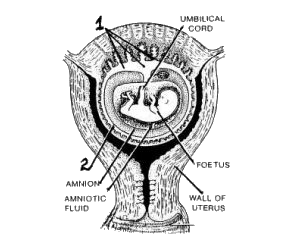Wharton's jelly present in umbilical cord is an example of
Adipose tissue
Mucus connective tissue
Areolar tissue
Elastic connective tissue.
The correct Answer is:B
To solve the question regarding Wharton's jelly present in the umbilical cord, we can follow these steps:
1. Understand the Components of the Umbilical Cord: The umbilical cord connects the fetus to the placenta and contains blood vessels that transport nutrients and waste. It is surrounded by a substance known as Wharton's jelly.
2. Identify the Options Given: The options provided are:
- Adipose tissue
- Mucous connective tissue
- Areolar tissue
- Elastic connective tissue
3. Analyze Each Option:
- Adipose Tissue: This type of connective tissue stores fat and is found beneath the skin and around internal organs. It is not related to the umbilical cord.
- Areolar Tissue: This is a loose connective tissue that provides support and is found around blood vessels and nerves. It does not specifically relate to the umbilical cord.
- Elastic Connective Tissue: This tissue allows for stretching and is found in areas like the skin, lungs, and arteries. It is not the correct type for the umbilical cord.
- Mucous Connective Tissue: This type of connective tissue is found during fetal development and is characterized by a jelly-like consistency. It is composed of a ground substance of glycoproteins and contains fine collagenous fibers and fibroblasts.
4. Conclusion: Since Wharton's jelly is a type of mucous connective tissue found in the umbilical cord, the correct answer is mucous connective tissue.
Final Answer:
Wharton's jelly present in the umbilical cord is an example of mucous connective tissue.
---
- Adipose tissue
- Mucous connective tissue
- Areolar tissue
- Elastic connective tissue
- Adipose Tissue: This type of connective tissue stores fat and is found beneath the skin and around internal organs. It is not related to the umbilical cord.
- Areolar Tissue: This is a loose connective tissue that provides support and is found around blood vessels and nerves. It does not specifically relate to the umbilical cord.
- Elastic Connective Tissue: This tissue allows for stretching and is found in areas like the skin, lungs, and arteries. It is not the correct type for the umbilical cord.
- Mucous Connective Tissue: This type of connective tissue is found during fetal development and is characterized by a jelly-like consistency. It is composed of a ground substance of glycoproteins and contains fine collagenous fibers and fibroblasts.
Wharton's jelly present in the umbilical cord is an example of mucous connective tissue.
Topper's Solved these Questions
- STRUCTURAL ORGANISATION IN ANIMALS BOOK - DINESH PUBLICATION ENGLISHCHAPTER - STRUCTURAL ORGANISATION IN ANIMALS EXERCISE - Check your grasp
10 Videos
- STEM BOOK - DINESH PUBLICATION ENGLISHCHAPTER - STEM EXERCISE - MULTIPLE CHOICE QUESTIONS
134 Videos
- STRUCTURE OF THE CELLBOOK - DINESH PUBLICATION ENGLISHCHAPTER - STRUCTURE OF THE CELLEXERCISE - Check your Grasp
17 Videos
Similar Questions
Knowledge Check
Vocal cords are present in
AglottisBepiglottisClarynxDtrachea
Study the diagram given below and then answer the questions that follow:

What is the role of the umbilical cord in the development of the foetus?
View SolutionThe spinal cord in man extends from the
View SolutionUmbilical cord suspends embryo in amniotic cavity and is attached to the midgut region of the embryo.In eutherians, this umbilical cord is formed of the stalk of
View SolutionRead the given statements. Statement A: Umbilical cord carries only foetal blood. Statement B: Structure which connects foetus to placents is umbilical cord. Choose the correct option.
View SolutionAssertion: Placenta is connected to the fetus by an umbilical cord.
Reason: Fetal components of placenta are derived from endometrium.
View Solutionvocal cords are situated at
View SolutionThe spinal cord is enclosed in
View Solution
